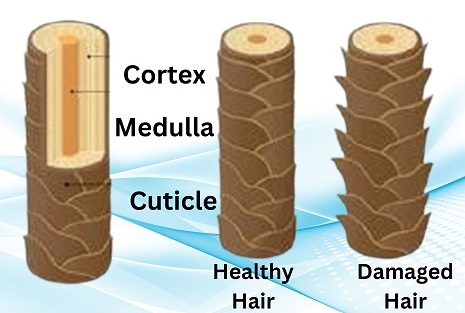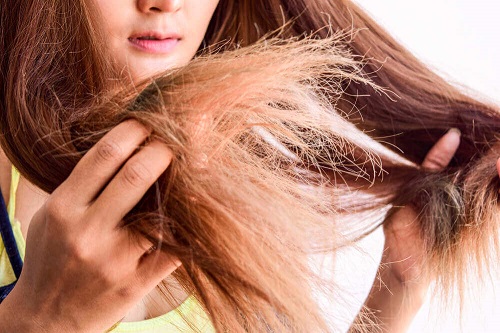You need to understand what does damaged hair look like if you want to maintain strong, healthy hair. Identifying the symptoms early on could help prevent further issues. Numerous things might cause damage, such as mishandling heat-producing equipment and exposure to adverse environments. This page may teach you how to identify hair damage, what to do to restore damaged hair, and the primary indicators of hair damage. It might be extremely important to identify the early indicators of damage, such as dryness, split ends, and increased hair breakage, in order to stop additional damage and make sure your hair stays strong and healthy.
Content:
- Understanding the Hair Cuticle
- What is Damaged Hair?
- Heat Damaged Hair
- Damaged Hair Strand
- Chemically Damaged Hair
- What Does Damaged Hair Look Like?
- Tips to Restore Damaged Hair
- Frequently Asked Questions about Damaged Hair
- In bottom lines on What Does Damaged Hair Look Like?
Understanding the Hair Cuticle

Let’s start by discussing what the hair cuticle is before moving on to the symptoms of damaged hair. Comprising of overlapping cells, the cuticle is the outermost covering of hair that shields the inner layers from damage. Smooth silky hair results from a cuticle that lies flat and is in good health. Frizzy hair, dryness, and breaking result from the cuticle lifting that occurs when it is damaged. So, how do you tell if your hair is damaged? The condition of the cuticle is a significant indicator.
What is Damaged Hair?

The cuticle is the outer layer of the hair that protects it. When the cuticle is damaged, the hair becomes dry, dull, and prone to breakage. This damage can be caused by using heat styling tools like straighteners, chemical treatments, pollution, and poor hair care. Heat-damaged hair occurs from using high temperatures, while sun-damaged hair results from too much UV exposure. Chemical treatments can lead to frizz and breakage, and when hair follicles are damaged, it can cause thinning and weak hair. Let’s see in detail!
Heat Damaged Hair

Heat-damaged hair often shows a loss of elasticity and natural shine and appears dry, brittle, and easily breaking. Frizz and split ends can result from overusing heat styling products, such as curling irons and straighteners, which weaken the structure of the hair.
Damaged Hair Strand

Roughness, fraying, and split ends are common indications of damaged hair strands, and the cuticle layer is clearly disturbed. It lacks the consistent, silky texture of healthy hair and may feel brittle to the touch. If left untreated, this decline might result in breakage and a dull look
Sun Damaged Hair

Sun-damaged hair frequently loses its natural shine and hydration and looks dry, brittle, and fading. Extended sun exposure can weaken the hair shaft, giving the hair a harsh texture and split ends.
Chemically Damaged Hair

Due to the harsh effects of dyes, relaxers, or perms, dryness, breakage, and an uneven texture are common characteristics of chemically damaged hair. Frizz and split ends can result from the chemical treatment, which can also deplete the hair of its natural oils and impair its structure.
Damaged Hair Follicles

Because damaged follicles have a compromised follicular structure and a restricted food supply, they can cause thinning hair and reduced growth. The following are common causes: overheating, unhealthy scalps, and severe treatments.
What Does Damaged Hair Look Like?
How to tell if your hair is damaged? Damaged hair can have a lifeless, frizzed-out appearance. It could not have the same sheen and smoothness as healthy hair, feeling brittle and rough to the touch. What symptoms indicate damaged hair? The following are some particular indicators:
1: Dry, Brittle Texture:

What does dry hair look like? Damaged hair frequently has a dry, brittle appearance. It might not have the glossy shine that comes from healthy hair. Males frequently have dry hair, especially when using styling chemicals that remove natural oils from their hair.
2: Split Ends and Dead Ends:

Split Ends and Dead Ends: Dead ends vs split ends—both are signs of damage. Split ends are the result of the cuticle wearing away, which splits the hair at the ends. Dead ends are more serious and signify that the hair needs to be cut because it can no longer be repaired.
3: Frizz and Flyaway:

If your hair is consistently frizzy and not just from humidity, it may be an indication of damage. Men with curly or wavy hair are more likely to have issues like frizz. Because of the peculiar structure of their hair, those with curly hair may experience more frizz.
4: Rough Hair Shaft:

In the middle of a hair strand is the hair shaft. Examining a damaged hair strand may reveal that it feels rough or hard. The shaft’s smoothness can be used to identify between healthy vs unhealthy hair; damaged hair can feel rough because of cuticle damage.
5: Lack of Elasticity:

Hair in good health can extend to some length. Should you find that your hair breaks easily when pulled, it could be a sign of damaged elasticity.
6: Dull Appearance:

How does damaged hair look like? healthy hair has a natural shine, whereas damaged hair does not. It frequently has a lifeless, dull appearance and poor light reflection.
7: Tangled and Knotty:

The rough cuticles of damaged hair often the problem on one another, causing the hair to tangle easily. This is especially noticeable in curly hair because knots may occur as hair strands interact.
8: Dead Hair and Unhealthy Hair:

What is dead hair? The term “dead hair” describes hair that has become so damaged that conditioning treatments have no effect on it. damaged hair photos usually show lifeless hair with a texture similar to straw.
9: Hair Under a Microscope:

If you were to look at damaged hair under a microscope, there would be noticeable damage shown by broken or elevated cuticles. Under magnification, on the other hand, healthy hair seems smooth and undamaged.
10: Healthy hair vs unhealthy hair:

One may tell the difference between healthy and unhealthy hair based on multiple factors. In comparison with unhealthy hair, which is frequently dull, rough, and at risk for breaking, healthy hair is flexible, shiny and smooth. How to know if your hair is healthy? When you run your fingers through it, healthy hair should feel silky and free of tangles.
12: Signs of Damaged Hair in Men

Damaged hair men experience can be different from ladies due to different grooming habits. How to know if your hair is damaged male? Men may notice problems like increased hair breakage, rough texture, or even thinning hair due to damage. How to tell if your hair is damaged for guys? Look for dryness, dullness and frizz or split ends.
Tips to Restore Damaged Hair:
Here are some suggestions to restore damaged hair:
1: Regular Trimming:

Removing split ends helps to sustain healthy hair development and stops additional breaking.
2: Use Deep Conditioning Treatments:

To repair and nourish your hair, use once a week deep conditioning masks or treatments that are high in proteins and moisture.
3: Limit Heat Styling:

Use less heat-producing appliances such as blow dryers, curling irons, and straighteners. Always use a heat protectant spray when using them.
4: Select the Correct Products:

Look for sulfate-free shampoos and conditioners made especially for damaged hair. Seek for components such as natural oils, biotin, and keratin.
5: Refrain from Over-Washing:

Too many washes might deplete your hair of its natural oils. Try to wash your hair twice or three times a week, and if needed, apply dry shampoo in between.
6: Sun Protection:

UV rays can exacerbate the damage already done to already brittle hair. When you’re outside, put on a hat or use UV-protective hair products
7: Include a Balanced Diet:

From the inside out, healthy hair originates. Make sure the vitamins, minerals, and proteins in your diet—such as biotin, vitamin E, and omega-3 fatty acids—support the health of your hair.
8: Steer clear of Tight Hairstyles:

Pulling your hair into tight braids, buns, or ponytails on a regular basis can contribute to breakage and tension. Choose looser hairstyles to ease your hair’s tension.
9: Silk pillowcase:

Sleep with a silk pillowcase to maintain your hair smooth and lustrous as they reduce friction, which can help avoid hair breakage.
10: Keep Yourself Hydrated:

Keeping your hair healthy requires drinking a lot of water. Maintaining adequate hydration maintains your hair and scalp healthy and resistant to harm.
You can stop more damage to your hair and restore its health with these suggestions.
Frequently Asked Questions about What Does Damaged Hair Look Like?
1: How do you tell if your hair is damaged?
You can tell if your hair is damaged by checking for dryness, split ends, frizz, and a dull appearance.
2: How to know if you have damaged hair?
Look for signs like frizz, split ends, and lack of elasticity. If your hair snaps easily when pulled or feels coarse, it’s likely damaged.
3: How does damaged curly hair look?
Damaged curly hair frequently has a frizzy, dry, and dull appearance. A few strands of the curls may lose their bounce and develop split ends, causing the curls to become uneven. Damaged curly hair must be properly hydrated and given loving care in order to regain its quality of life.
4: How to prevent damaged hair for men?
Men can prevent hair damage by using gentle hair care products, avoiding excessive heat styling, and getting regular trims to remove split ends.
5: Is Keratin Treatment Good for Hair?
Hair can be strengthened and smoothed with keratin treatment, which also reduces frizz and improves maintenance. It’s crucial to remember that the treatment contains chemicals, which, if repeated regularly, may weaken the hair over time.
6: how does a strand of damaged hair look?
A strand of damaged hair may look rough and uneven, with apparent frizz or split ends when inspected closely.
7: How to know if your hair is damaged male?
The signs are similar for men and women, but men may notice additional issues due to different grooming habits. For example, using heavy styling products, frequent washing, or rough towel drying can exacerbate damage.
6: HOW TO FIX HEAT DAMAGED HAIR?
Restoring moisture and fortifying the structure of the hair are necessary for heat-damaged hair repair. Apply deep conditioning treatments and hydrating hair masks to replenish moisture, and use protein-rich products to fortify the hair. To avoid more damage and get rid of split ends, trim frequently.
In bottom lines on What Does Damaged Hair Look Like?
Recognizing the signs of hair damage is the first step toward healthy hair. Identifying the symptoms and taking the necessary steps is important, regardless of whether you’re wondering how to determine if your hair is damaged or looking for ways to restore it. Men may find damaged hair particularly annoying, but with the right treatments and maintenance, you can bring your hair back to health and brightness. By taking care of damage as soon as possible and following to a regular hair care plan, you may be able to prevent more issues and have stronger, healthier hair.









